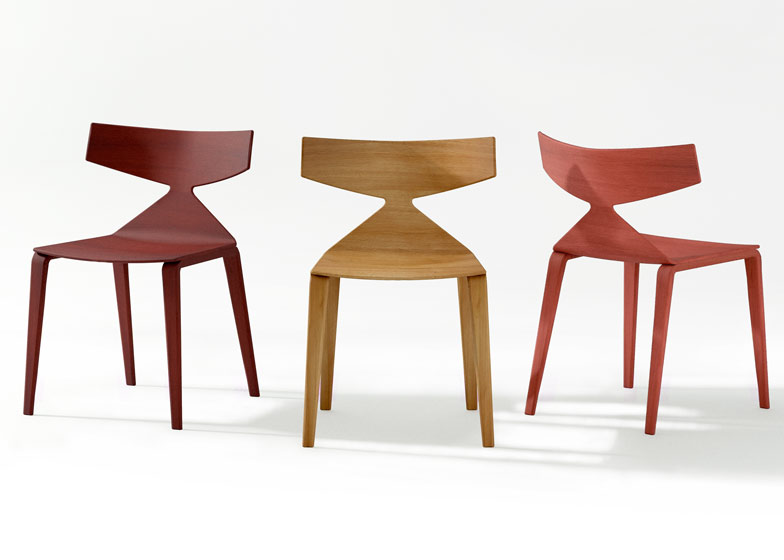Dezeen promotion: Italian furniture brand Arper is showcasing two of its latest chair collections at a new London showroom, which opens in Clerkenwell next week.
Above and top: Saya collection by Lievore Altherr Molina
The first collection, called Saya, is designed by Barcelona studio Lievore Altherr Molina and features oak veneer chairs with hourglass-shaped backs.
Above: Saya collection by Lievore Altherr Molina
The Juno collection by designer James Irvine features lightweight plastic chairs cast in a single form, which are are available in a range of colours and styles.
Above: Saya collection by Lievore Altherr Molina
The Arper showroom is located at 11 Clerkenwell Road, London EC1M 5PA.
Above: Saya collection by Lievore Altherr Molina
Here's some more information from Arper:
Arper launches new Juno and Saya chairs to the UK market
Treviso-based furniture design company Arper open their London showroom in October 2012 and present its two new collections: Juno and Saya. These two collections differ quite dramatically in terms of style and material yet both are entirely reflective of Arper’s commitment to systems and adaptability.
Above: Juno collection by James Irvine
Saya - design by Lievore Altherr Molina 2012
Saya takes its inspiration from nature and a sense of ‘home’ – it evokes feelings of warmth through its material and life in its form. It’s a striking and unique graphic sign, rendered in wood. Its graceful curves resemble that of a small animal – a deer - with four legs and an arching neck.
Above: Juno collection by James Irvine
Arper sees the chair as something of a manifesto, an ode to wood and a celebration of the organic. It’s about using fluid, expressive lines to create something inviting. The shape of the chair’s back is a gesture – like a spread of the arms to invite an embrace.
Above: Juno collection by James Irvine
With an oak veneer, Saya’s colour finishes include natural, white, black, ochre, teak and three shades of red which complement individual or group use. Designed with residential and corporate uses in mind, Saya fits into every environment like all Arper products. The legs are also customisable in the Arper tradition in wood or chrome.
Above: Juno collection by James Irvine
Juno - design by James Irvine, 2012
Juno is Arper’s vision for the future of the plastic chair – with the design concept closer to that of a solid wood chair. It is Arper’s first piece made entirely of gas-assisted injection-molded polypropylene. Cast in a single form, it is incredibly light in silhouette, weight and impact.
Above: Arper's new showroom in Clerkenwell, London
It is simple and uniform but not without personality – an exciting expression of the technology used to develop Juno, whilst remaining true to the fluidity and beauty of all Arper products.
Above: Arper's new showroom in Clerkenwell, London
Juno is all about efficiency and versatility. It’s ideal for both residential and corporate environments, both indoor and outdoor. This singular, simple shape is available in five colors – white, sand, anthracite, orange, yellow – with closed or open back, with or without armrests.
Above: Arper's new showroom in Clerkenwell, London
It can also be customised with sleek upholstery for the seat and backrest, with all variations stackable to allow for large-scale use and storage.
Above: Arper's new showroom in Clerkenwell, London
Living Systems
Arper’s approach revolves around the historic notion of ‘Living Systems’, a theory that studies how different elements, affected by context and interaction, create spontaneously organized structures.
Above: Arper's new showroom in Clerkenwell, London
In applies to Arper’s approach to the design of new products but also to the way these products are presented, interpreted and expressed.
Above: Arper's new showroom in Clerkenwell, London
Arper’s intention is to create products that can adapt and interact with the context they are intended for. Saya and Juno represent different – but balancing – aspects of this.
Above: Arper's new showroom in Clerkenwell, London
An open-ended and generous design approach allows for an exchange between the environment and the product. The products are only finished when their context has been decided.

